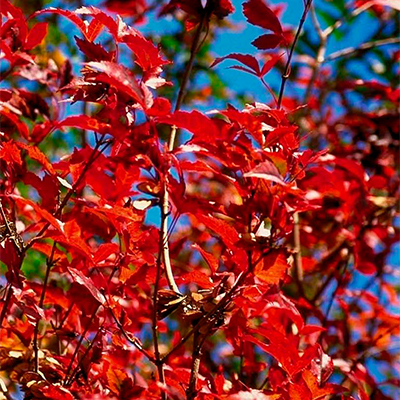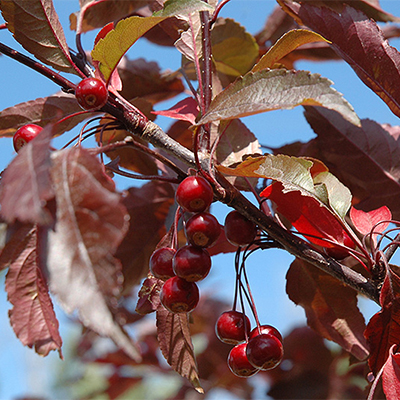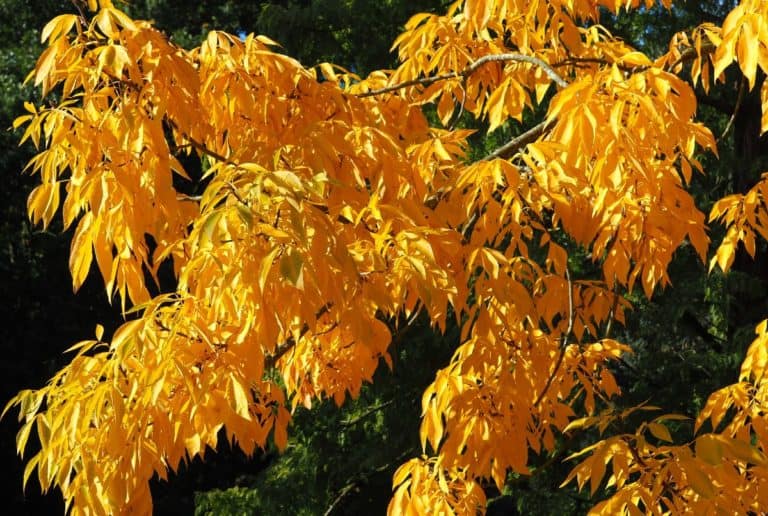When autumn arrives, golden yellow tree leaves provide a bright pop of color against the darker reds, oranges, and browns. While large shade trees like maples and oaks are renowned for their fall foliage, small ornamental trees offer big impact in compact packages. Their relatively petite size – often maxing out below 25 feet tall at maturity – makes them ideal choices where space is limited.
If you are looking to add cheerful yellow fall color to your landscape, check out these top small tree picks blooming with vibrant yellow leaves in autumn. With their dazzling golden hues, these compact trees will light up your yard come fall.
Japanese Maples
Japanese maples (Acer palmatum) are treasured for their artistic form, fine-textured leaves, and blazing fall color. While most varieties turn shades of red and orange, some selections put on a sensational yellow leaf display.
One of the best is ‘Mikawa Yatsubusa’ – a dwarf, mounding Japanese maple that grows just 6-8 feet tall and wide. Its small stature suits Asian-inspired gardens or containers. Deeply cut green leaves transition to brilliant clear yellow in fall for weeks of color. Protect from hot afternoon sun.
For bolder impact look for ‘Moonfire’ Japanese maple. This vase-shaped small tree can reach 15 feet tall and wide, but often remains more compact. Its foliage unfurls bright red in spring summer’s green, then transforms to vibrant yellow in autumn. The color is boldest in full sun.
Serviceberry
Serviceberry (Amelanchier) encompasses a group of multi-season trees. White spring flowers sweet summer berries and yellow to orange-red fall foliage make them excellent additions to yards big and small. Most mature around 15-25 feet tall.
Autumn Brilliance® serviceberry is one of the most popular varieties, valued for its prolific display of yellow fall color. Oval green leaves cloak the branches through summer before transitioning to brilliant yellow and apricot shades in fall. White blooms in spring become edible berries. Grows 15-20 feet tall. Full sun to part shade.
For a more upright form, choose Princess Diana serviceberry. This narrowly columnar selection only spreads to 8 feet wide but shoots up 20 feet tall. Light green foliage warms up to golden fall tones. Pairs nicely with evergreens. Tolerates heat and periods of drought once established.
American Smoketree
Looking for serious wow-factor? American smoketree (Cotinus obovatus) has you covered. This small flowering tree maxes out around 20 feet tall and wide with an oval form. Its claim to fame is the purplish, fluffy flower panicles that cover the branches all summer long. These fade and dry to a beige, smoky effect – hence the name.
In fall, the large round leaves turn brilliant shades of yellow, gold, and orange. For best color, grow American smoketree in full sun with well-drained soil. Responds beautifully to yearly pruning. No major pest or disease issues.
Golden Raintree
One of the brightest small trees for fall is golden raintree (Koelreuteria paniculata). Native to China, this underutilized beauty can reach 30 feet tall and wide but often remains smaller. It really packs a visual punch with its huge clusters of yellow flowers in summer followed by papery lantern-like seed capsules.
Come autumn, the pinnate compound leaves transition from green to unbeatable golden yellow tones. For the best fall color, grow golden raintree in full sun and provide occasional deep watering in dry periods. Prune in early spring to maintain shape. Extremely pest and disease resistant.
Amur Maackia
Looking for a hardy, low-maintenance small tree? Look no further than Amur maackia (Maackia amurensis). This tough, adaptable tree grows 20-30 feet tall and withstands cold winters, periods of drought, urban pollution, and clay soil. It offers pleasantly scented white summer flowers plus lush green compound leaves.
In autumn, those emerald leaves transform to glowing shades of gold and yellow. For the brightest fall color, plant Amur maackia in full sun. Pairs nicely with evergreens. Tolerates part shade. Requires little pruning and no fussing once established. Nearly pest and disease free.
Paperbark Maple
Valued for its year-round appeal, paperbark maple (Acer griseum) offers cinnamon-colored peeling bark plus spectacular fall color. This slow-growing tree typically reaches 20-30 feet tall and wide, with an oval to rounded form. The trifoliate leaves emerge reddish-purple before turning green.
In autumn, those leaves morph into brilliant mandarin-orange to reddish-purple tones, often with vibrant yellow highlights. For optimal fall color, plant paperback maple in partial sun to light shade. Provide consistent watering. One of the most beautiful small trees once established.
American Yellowwood
American yellowwood (Cladrastis kentukea) deserves more use in landscapes. This trouble-free North American native grows 30-50 feet tall and wide with a rounded form. Fragrant white pea-like flowers dangle from the branches in spring. The compound leaves remain green through summer.
When autumn arrives, those leaves shift to hues of clear yellow, gold, and chartreuse – a striking color change. Yellowwood does best in full sun to part shade with well-drained soil. Avoid overly wet conditions. Once established, it’s carefree with no pests or diseases. Responds well to pruning.
Goldenchain Tree
Another fantastic spring bloomer is goldenchain tree (Laburnum x watereri). This small hybrid tree typically matures at 20-25 feet tall. It really dazzles in spring when the drooping racemes of vibrant yellow pea-like flowers appear. It looks as though chains of yellow flowers are draped on the branches.
The green compound leaves provide a nice backdrop before taking on golden fall tones. For best growth and flower production, plant goldenchain tree in full sun to part shade. Prefers evenly moist, well-drained soil but adapts to most conditions. Does well in alkaline soil. Resists pests and diseases.
Tuliptree
A classic shade tree that stays small is tuliptree (Liriodendron tulipifera). Most max out around 70-100 feet tall, but ‘Little Volunteer’ tuliptree only grows 20 feet tall and wide. The unique tulip-shaped greenish-yellow and orange flowers bloom in spring and give way to 4-lobed leaves.
In fall, those broad leaves transform to brilliant clear yellow – a stunning sight! Provide full sun, reasonable drainage, and occasional deep watering. Makes a fine specimen in a residential yard. Pest and disease free once established.
Crapemyrtle
Known for their long bloom period, crapemyrtles also provide gorgeous fall foliage. While most varieties turn red, orange, or purple, certain cultivars like ‘Acoma’ shift to bright yellow in autumn. This semi-dwarf crapemyrtle stays under 10 feet tall with white summer blooms and brilliant yellow fall color.
For more height, choose ‘Natchez’ white crapemyrtle. It matures around 20-25 feet tall with a cinnamon-colored bark that adds winter interest. The summer flowers transition to vibrant yellow leaves in fall. Plant in full sun for optimal growth, blooms, and fall color. Heat and drought tolerant once established.
Franklinia
Franklinia alatamaha is a unique small tree that typically grows 15-25 feet tall. Sometimes called franklinia or franklin tree, its white camellia-like blooms first appeared in the late summer and continue into fall. This member of the tea family was discovered in Georgia in 1770 and thought extinct in the wild.
The 2 to 5-inch wide glossy green leaves turn brilliant shades of yellow and gold in autumn. For the best fall color, grow franklinia in full sun to part shade. Provide consistent moisture and well-drained acidic soil. Does well in containers. Organically rich soil encourages flowering.
Other Top Small Trees for Yellow Fall Foliage:
- Flowering goldenraintree
- Black tupelo
- Amur chokecherry
- Smooth sumac
- Witch hazel
- Fringetree
- American bladdernut
- Sweetgum (‘SLENDER SILHOUETTE’ is a narrow cultivar well-suited to smaller yards)
With their compact sizes and glowing yellow autumn leaves, these small trees pack a lot of visual impact into garden-friendly packages. Plant one or more to light up your landscape with fall color. Take time to appreciate their golden splendor during autumn strolls before the leaves fall.
Trees That Turn Red in Fall
A thrilling, densely-branched, small tree with highly dramatic foliage color. Spring leaves are brilliant salmon-red, green in midsummer, then turn a brilliant orange-scarlet in autumn. New growth continues to emerge red, contrasting beautifully with the mature foliage. Fits well in small spaces and containers. Partial shade to filtered or partial sun. Slow growing; reaches 7-9 tall and wide in 10 years. Zones 5-8.

Brilliant red foliage lights this small, versatile, and bushy tree aflame in fall. A wonderful bare-stemmed silhouette appears after leaves fall, and fragrant flowers appear in spring. Excellent cold tolerance. Partial to full sun. Up to 20′ tall and wide. Zones 2–7.
A delightful composition of mixed textures with big feathery plumes and large rounded leaves. Foliage is a vibrant wine red when young, darkening to a plum red at maturity. Expect brilliant shades of orange-red in the fall. Performs even in rocky, infertile soils! Partial to full sun. Up to 15 tall and wide. Zones 4-8.
An attractive ornamental shrub or small tree with showy, ruffled, fiery red summer flowers. These are followed by vibrant orange-red fall foliage. An excellent choice as a specimen plant. Or en masse for an explosion of color in the landscape and year-round interest. Full sun. Up to 20 tall, 15 wide. Zones 6-10.
This compact, shrubby tree has gorgeous foliage that becomes purple-red with orange-red patterns in fall. The color is most intense in full sun and is less likely to sunburn than other varieties. Popular for bonsai, as a container specimen, and in small gardens. Highly sculptural form improves with age. Partial to full sun. Up to 15 tall, 10 wide. Zones 5-8.

The unique cut-leaf foliage starts out wine-red and turns burgundy-tinged as it ages. In the fall, it turns bright orange-red. And bright pink spring flowers turn to showy red-purple fruit, too! Full sun. 20′ tall, 15′ wide. Zones 4–8.
Trees That Turn Orange in Fall
Theres rarely a moment with this outstanding small tree doesnt look great. Although fall is when it hits its zenith with foliage in varying shades of gold, orange, and red. Partial to full sun. Up to 12′ tall, 8′ wide. Zones 5–7.
Beautiful creamy yellow and coral red stems make a striking winter specimen. Rich green leaves clothe the stems through summer and turn orange and yellow in fall. Reaches 8 to 10 ft. tall in ten years; 12 to 18 ft. tall, 10 to 15 ft. wide at maturity. Zones 5-9.
An exciting colorful evergreen! Sunny yellow new growth emerges in striking contrast to maturing chartreuse to bright-green foliage. The real drama arrives when the weather cools. Then it transitions to deep gold, with glowing orange to russet red tips in fall. Up to 25 tall, 8 wide. Full sun. Zones 5-8.
Are your CITRUS TREE LEAVES going yellow? What causes it and how do you fix it?
FAQ
What tree has small yellow leaves?
What is the name of the tree that is yellow?
What tree has golden foliage?
- The Ultimate Guide to Growing Strawberries in Raised Beds - August 8, 2025
- No-Dig Garden Beds: The Easiest Way to Grow a Beautiful Garden - August 6, 2025
- How to Protect and Preserve Wood for Raised Garden Beds - August 6, 2025

